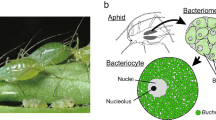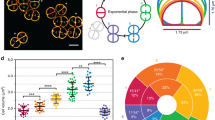Summary
Strain CL ofPhysarum polycephalum forms multinucleate plasmodia within clones of uninucleate amoebae. The plasmodia have the same nuclear DNA content as the amoebae. Analysis of plasmodial development, using time-lapse cinematography, showed that binucleate cells were formed as a result of nuclear division in uninucleate cells. Binucleate cells developed into plasmodia by further nuclear divisions and cell fusions. No fusions involving uninucleate cells were observed. A temporary increase in cell and nuclear size occurred at the time of binucleate cell formation.
Similar content being viewed by others
References
Aldrich, H. C., 1967: The ultrastructure of meiosis in three species ofPhysarum. Mycologia59, 127–148.
Arescaldina, I., 1971: Evolution de la teneur en ADN des noyaux dePhysarum polycephalum (Myxomycètes) au cours de la sporulation. C. R. Acad. Sci. (Paris)273, 398–401.
Bailey, N. T. J., 1959: Statistical methods in biology. London: The English Universities Press Ltd.
Cooke, D. J., 1974: Studies on the Colonia isolate ofPhysarum polycephalum. Ph. D. Thesis, University of Leicester.
—, andJ. Dee, 1974: Plasmodium formation without change in nuclear DNA content inPhysarum polycephalum. Genet. Res. (Camb.)23, 307–317.
— —, 1975: Methods for the isolation and analysis of plasmodial mutants inPhysarum polycephalum. Genet. Res. (Camb.)24, 175–187.
Dee, J., 1960: A mating-type system in an acellular slime-mould. Nature185, 780–781.
—, 1966: Multiple alleles and other factors affecting plasmodium formation in the true slime mouldPhysarum polycephalum Schw. J. Protozool.13, 610–616.
Harris, H., 1967: The reactivation of the red cell nucleus. J. Cell Sci.2, 23–32.
Howard, F. L., 1931: The life history ofPhysarum polycephalum. Amer. J. Bot.18, 116–132.
Hoxmark, R. C., andØ. Nordby, 1974: Haploid meiosis as a regular phenomenon in the life cycle ofUlva mutabilis. Hereditas76, 239–250.
Kerr, N. S., 1967: Plasmodium formation by a minute mutant of the true slime mouldDidymium nigripes. Exp. Cell Res.45, 646–655.
Kerr, S. J., 1967: A comparative study of mitosis in amoebae and plasmodia of the true slime mouldDidymium nigripes. J. Protozool.14, 439–445.
Mohberg, J., K. L. Babcock, F. B. Haugli, andH. P. Rusch, 1973: Nuclear DNA content and chromosome numbers in the MyxomycetePhysarum polycephalum. Dev. Biol.34, 228–245.
—, andH. P. Rusch, 1971: Isolation and DNA content of nuclei ofPhysarum polycephalum. Exp. Cell Res.66, 305–316.
Wheals, A. E., 1970: A homothallic strain of the MyxomycetePhysarum polycephalum. Genetics66, 623–633.
—, 1973: Developmental mutants in a homothallic strain ofPhysarum polycephalum. Genet. Res. (Camb.)21, 79–86.
Author information
Authors and Affiliations
Rights and permissions
About this article
Cite this article
Anderson, R.W., Cooke, D.J. & Dee, J. Apogamic development of plasmodia in the myxomycetePhysarum polycephalum: a cinematographic analysis. Protoplasma 89, 29–40 (1976). https://doi.org/10.1007/BF01279326
Received:
Issue Date:
DOI: https://doi.org/10.1007/BF01279326




